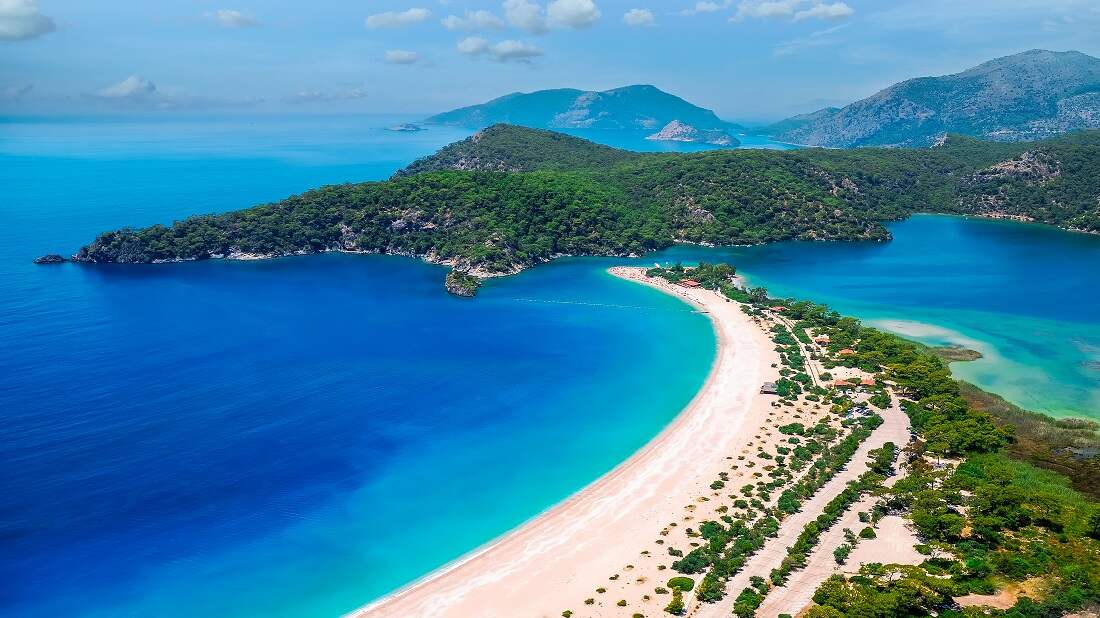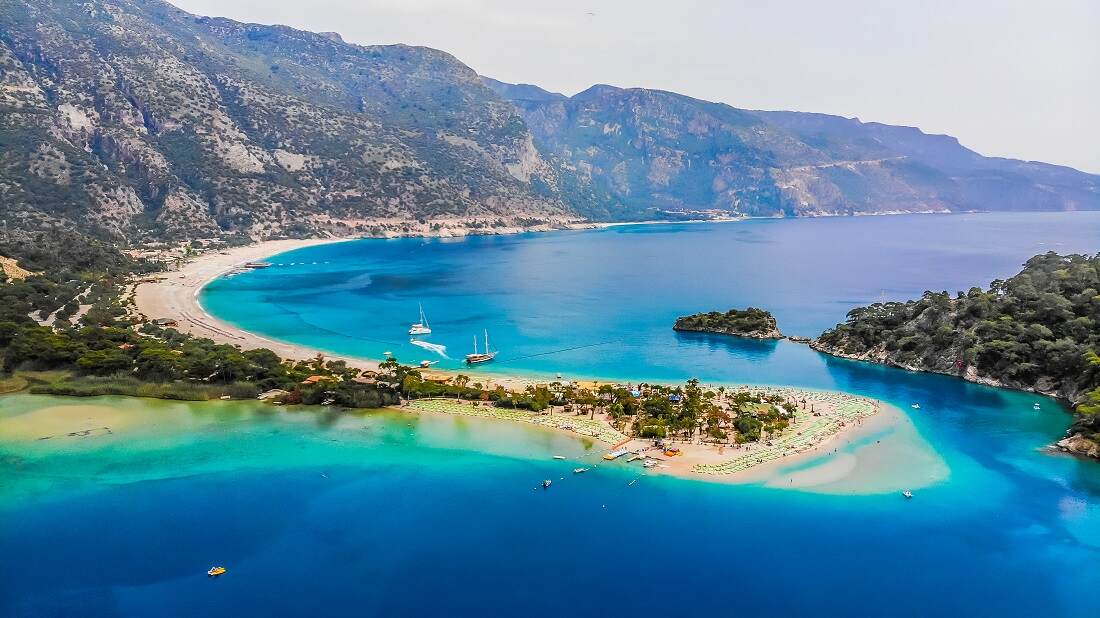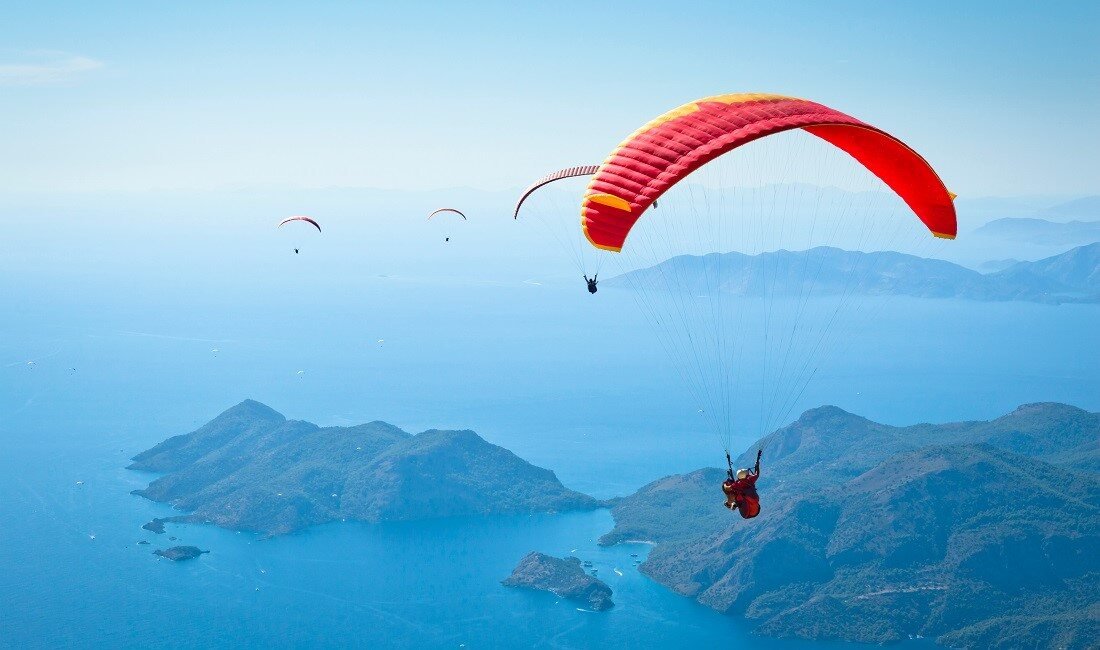
Blue Lagoon (Oludeniz) is a stunning natural wonder on the Turkish Riviera in southwestern Turkey. It is one of Turkey’s most popular tourist attractions, drawing thousands of visitors annually. It is a picturesque bay with crystal-clear turquoise water that blends with a beautiful white sand beach. The lagoon is surrounded by lush green forests and rocky cliffs, making it a breathtaking sight.
The area’s geological history is fascinating, with its unique landscape shaped by millions of years of tectonic activity. The Babadağ mountain range encircles the Blue Lagoon and comprises limestone and dolomite rocks. These rocks have been slowly eroded by rainwater over time, creating deep valleys and gorges that are now popular hiking trails for tourists.
The limestone and dolomite rocks also contain high levels of calcium carbonate, which gives the water in the lagoon its distinctive blue-green color. This color is particularly striking when the sun shines on the water and is one of the primary reasons why the Blue Lagoon is such a popular subject for artists and photographers.
The Blue Lagoon was formed around 5,000 years ago during the late Bronze Age, making it one of the oldest natural wonders in the region. The lagoon’s unique location and formation have contributed to its natural beauty and protected it from the effects of the open sea. The lagoon is fed by several freshwater streams that flow down from the surrounding mountains, providing a constant supply of fresh water. Additionally, underground springs filter through the porous limestone and dolomite rocks, ensuring that the water in the lagoon remains crystal clear and refreshing.

1. The Lycian Era
The Lycians were an ancient civilization that inhabited the region around the Blue Lagoon in Turkey from 2000 BCE to the 6th century BCE. They were known for their seafaring skills and were one of the earliest to establish trade networks in the Mediterranean. The Lycians utilized the natural harbors and bays along the coast to develop their cities and trade routes with other civilizations.
In addition to their trading skills, the Lycians were known for their remarkable artistic abilities. Their art is still admired today and has contributed significantly to ancient art. Some of the most notable examples of Lycian art include the rock tombs carved into the cliffs overlooking the Blue Lagoon. The Lycians believed in the afterlife and constructed these tombs to ensure their dead had a comfortable journey into the next world. They adorned the tombs with intricate carvings depicting scenes from daily life, including hunting, fishing, farming, mythical creatures, and gods.
The Lycians were a democratic people and had a complex system of governance. In addition, they had a unique language and an alphabet that still needs to be fully understood. Despite this, they established themselves as a powerful force in the Mediterranean world, and their cultural and artistic achievements continue to inspire scholars and tourists alike. Today, the Lycian civilization is recognized as one of the most influential ancient cultures in the region, and their influence is still alive in Turkey’s art, architecture, and culture.
2.The Byzantine Era
The Byzantine era in the region around the Blue Lagoon in Turkey began in the 4th century CE and lasted until the 15th century CE. At this period, most people accepted Christian doctrine as standard practice. As a result, the region was home to several churches and monasteries built to spread Christianity. In addition, they constructed many religious sites on the Blue Lagoon’s hillsides, providing a peaceful and tranquil setting for contemplation and worship.
The Blue Lagoon was also a popular destination for pilgrims seeking spiritual guidance and participating in religious ceremonies. The lagoon’s natural beauty and tranquil atmosphere made it an ideal location for contemplation and meditation. Many pilgrims believed that the Blue Lagoon had healing powers and would immerse themselves in its waters in the hope of curing their ailments.
Significant religious and cultural developments marked the Byzantine era in the region. However, the churches and temples built during this time show that Christianity has been vital in the area for a long time. The Blue Lagoon continues to be a popular destination for tourists and pilgrims, and its rich religious history makes it an essential part of the cultural heritage of Turkey.
3. The Ottoman Era
The Ottoman Empire captured the region around the Blue Lagoon in the 15th century. The Ottomans ruled the area for more than four centuries. They significantly changed the region’s political and social landscape during this time. The Blue Lagoon, an important trading center during the Byzantine era, was primarily used as a port for exporting the region’s agricultural products under Ottoman rule. The Ottomans were known for their efficient trade networks, and the Blue Lagoon became essential to their trading routes.
During the Ottoman period, the region experienced significant cultural and economic growth. The Ottomans built several impressive buildings and mosques in the region, and their influence can still be seen in the area’s architecture and culture. The Blue Lagoon remained a critical trading center throughout the Ottoman period, and its strategic location made it a vital hub for trade with the eastern Mediterranean.
After World War I, Turkey gained independence. The region around the Blue Lagoon became a part of the new Turkish Republic. However, the Blue Lagoon remained a crucial hub of trade and commerce throughout the early years of the Turkish Republic, despite significant political, social, and economic changes.
4. The Modern Era
Since the late 20th century, the Blue Lagoon has become a top-rated tourist destination, attracting thousands yearly visitors. The area’s natural beauty and unique geological features, including the stunning turquoise waters and the surrounding mountains, have made it a favorite spot for nature lovers and adventure seekers. The lagoon has also been the subject of numerous works of art, including paintings, photographs, and sculptures. In addition, the lagoon’s beauty and tranquility have drawn many artists, and their works of art promoted the area as a cultural destination.
The Blue Lagoon has also been featured in several films and television shows, including the James Bond film “Skyfall,” which was partly filmed in the region. The exposure from such high-profile productions has helped to raise the area’s profile and attract even more regional visitors. In addition, the lagoon’s popularity as a tourist destination has significantly impacted the local economy, creating jobs and generating income for the surrounding communities.

The lagoon is approximately 900 meters long and 250 meters wide, with a maximum depth of 60 meters. The water temperature in the lagoon ranges from 19 to 25 degrees Celsius, making it perfect for swimming, snorkeling, and diving. In addition, the nearby mountains and forests are home to various endangered plants and animal life. From here, world-famous sunsets and panoramic views of the Aegean Sea may be observed.
Blue Lagoon has a high salt content, which makes it buoyant and provides a therapeutic effect on the skin. In addition, the water is also rich in minerals, including magnesium, calcium, and potassium, which have healing properties for various ailments.
Another unique feature of the Blue Lagoon is its underwater cave system, a popular spot for scuba diving and exploration. The cave system is home to several species of marine life, including colorful fish, sea turtles, and octopuses.
The Blue Lagoon is home to diverse wildlife and flora, including several rare and endangered species. Dense forests and mountains, home to various plants and animals, including wild boar, deer, and several species of birds, surround the lagoon. Snorkelers and scuba divers love the region for its abundance of colorful marine life and the opportunity to explore its many underwater caves and reefs.
The Blue Lagoon is particularly renowned for its diverse plant life, which includes several highly uncommon and even extinct species. In addition, the surrounding forests are home to several species of oak, pine, cypress trees, wildflowers, and herbs. The Blue Lagoon is a rich and diverse ecosystem with a unique terrestrial and marine life blend. Those interested in wildlife and the outdoors frequently visit this area.

Paragliding: The Babadağ mountain range, which surrounds the Blue Lagoon, is a trendy spot for paragliding. It has become a world-famous activity in recent years. Visitors can take a tandem flight with an experienced pilot and soar above the lagoon, enjoying an excellent coastline view.
Relaxation and Beach Activities: If you want to unwind and bask in the sun, the Blue Lagoon is the place to go. Several beautiful beaches surround the lagoon, ideal for sunning, swimming, and unwinding. Beach umbrellas and chairs can be rented, or guests can throw a towel on the sand and enjoy the waters of the Aegean Sea.
Water Sports: The Blue Lagoon is a popular destination for water sports enthusiasts, with various activities available to visitors. Jet skiing, water skiing, wakeboarding, and banana boat rides are all popular activities in the lagoon, with several rental shops and operators located nearby.
Scuba Diving: The Blue Lagoon is renowned for its underwater caves and reefs. Hence it is a popular destination for scuba diving. Several dive shops and operators offer guided tours of the underwater caves and reefs, allowing visitors to explore the fascinating marine life and underwater rock formations.
Boat Tours: A boat tour is a popular way to explore the Blue Lagoon and its coastline. Visitors can tour the lagoon, visit nearby beaches and coves, or explore the rugged coast and its hidden bays and coves.

Kayakoy: Kayakoy was once a thriving Greek Orthodox community before the population exchange between Greece and Turkey in 1923. Today, the village stands abandoned, with its churches, houses, and streets preserved as a ghost town. Visitors can wander through the deserted village and explore the ruins of the Greek Orthodox Church, the schoolhouse, and the old village baths. Kayakoy is a unique and haunting destination, offering a glimpse into Turkey’s complex history and cultural heritage.
Tlos: Tlos is an ancient city that once was a critical center of the Lycian civilization, dating back to the 2nd century BCE. The town is famous for its impressive ruins, including a well-preserved acropolis, a Roman theater, and a bath. Visitors can explore the city’s ruins and admire its fantastic architecture and art, including Lycian rock tombs and Byzantine-era churches. The site also offers a picturesque view. Tlos is on UNESCO World Heritage Site Tentative List.
Pinara: Pinara is an ancient city in southwestern Turkey’s Xanthos River valley. It was an important center of the Lycian civilization and had a rich history dating back to the 5th century BCE. The city’s impressive ruins include a well-preserved theater, an agora, and rock-cut tombs. Visitors can explore the city’s ruins and admire its unique architecture and art, including the intricate carvings on the rock-cut tombs. Pinara also offers stunning views of the surrounding valley and mountains. Pinara is on UNESCO World Heritage Site Tentative List.
Letoon: Letoon was also an important religious center in the ancient Lycian civilization. Letoon is a designated UNESCO World Heritage Site because of its historical significance. The city is home to three temples dedicated to the gods Apollo, Artemis, and Leto, the mother of Apollo and Artemis. The temples were built in the 4th century BCE. They are notable for their well-preserved architectural features, including marble columns and ornate carvings. Visitors can explore the city, including the remains of the temples, a theater, and several other structures.
Xantos: Xanthos was an ancient city in the Lycia region of Turkey. It was known for its strategic location and was an important center for trade during its peak. The town was also known for its unique architectural style, which blended elements of both Greek and Lycian cultures. Xanthos was designated a UNESCO World Heritage Site in 1988, and many of its ruins, including the Nereid Monument, still attract visitors worldwide.
Telmessos: Telmessos was an ancient city in Anatolia’s Lycian region, now modern-day Fethiye in Turkey. It was renowned for its strong navy and navigational skills. In addition, it was an important center of trade and commerce in the region. Telmessos was also home to several significant cultural and architectural landmarks, including the Tomb of Amyntas, a well-preserved Lycian rock tomb, and the ancient theater, which could seat up to 5,000 spectators.
Sidyma: Sidyma was an ancient city in southern Turkey near the present-day town of Dodurga. The city was a part of the Lycian Alliance and was essential to the region’s history. The city’s ruins include a well-preserved theater, several coffins, and the remains of a large agora. Sidyma is also known for its ancient rock tombs carved into the cliffs overlooking the city.

Kabak Beach: Kabak Beach is a stunning and peaceful beach close to the Blue Lagoon. The beach is beautifully surrounded by a lush green forest, providing an excellent opportunity for swimming and snorkeling in crystal-clear water. The area is a beautiful destination for backpackers and nature lovers eager to discover the region’s stunning natural beauty. The beach is surrounded by many small guesthouses and campsites, providing ample options for a comfortable stay for a few days. In addition, the beach is the starting point of hiking trails that lead to stunning waterfalls and breathtaking scenic viewpoints.
Kidrak Beach: Kıdrak Beach is a stunning and peaceful beach close to the Blue Lagoon. It’s an excellent spot for people who want to enjoy a calm and soothing environment. The beach’s beautiful sand and turquoise sea are picture-perfect for a day of relaxation. The beach is beautifully nestled amidst pine forests, offering a peaceful and picturesque setting. Kidrak Beach provides a fantastic campsite experience, allowing visitors to stay in cozy tents or bungalows surrounded by stunning natural beauty. The beach is conveniently accessible by public transportation or car, and the area boasts a lovely cafe.
Gemile Bay: Gemile Bay in Fethiye, Turkey, is beautiful and quiet. Pristine seas and green hills make this bay perfect for water sports like swimming, snorkeling, and sunbathing. You can also see the ancient ruins of St. Nicholas Island from the bay. It’s easy to get to Gemile Bay by boat or automobile, making it a favorite getaway for visitors looking for peace.
Knight Island: Knight Island (Sovalye Adasi) is a charming island in the beautiful Fethiye Bay, having pristine beaches, crystal-clear waters, and stunning natural beauty. The island is exclusively reachable by boat, and visitors can relish swimming, sunbathing, and snorkeling in the stunning turquoise waters. The island has fantastic restaurants and cafes serving mouth-watering seafood and refreshing drinks. Several ancient ruins, such as a Byzantine church and castle, enhance Knight Island’s historical significance.
Paradise Bay (Cennet Koyu): Paradise Bay is renowned for its stunning turquoise waters, pristine white sandy beach, and picturesque green hills enveloping it. The bay is between two rocky headlands. Visitors can bask in the sun and discover the vibrant underwater world through snorkeling while taking in the breathtaking views of the bay. The beach is accessible by boat or foot. It is the perfect destination for a secluded day.
Butterfly Valley (Kelebekler Vadisi): Butterfly Valley is a stunning canyon home to some of the most unique butterfly species in the world. Getting to the valley by boat or a steep trail enhances its tranquil ambiance. Visitors can swim in the clear waters, relax on the beach, and explore the hiking trails that lead to secret waterfalls and beautiful views. The Butterfly Valley is a fantastic destination for nature enthusiasts who seek a peaceful escape from the hustle and bustle of everyday life.
Calis Beach: The beach is famous for tourists because of its long stretch of sand. Visitors can swim, sunbathe, and do water sports like windsurfing and kiteboarding at the beach. In addition, you’ll find plenty of places to buy and eat fabulous local fare and sip cold drinks and cocktails along the shoreline. Calis Beach also has a beautiful view of the sun at sunset, making it an excellent place for a romantic walk at night.

We highly encourage travelers to add the Blue Lagoon to their itinerary when visiting Turkey. The Blue Lagoon offers something for everyone, whether you’re seeking a relaxing getaway, a chance to immerse yourself in a new culture, or an exciting adventure. From its stunning beaches and crystal-clear waters to its nearby historical sites, there’s no shortage of activities to enjoy. In addition, the area’s warm hospitality and rich culture make it a welcoming and memorable destination.
In summary, the Blue Lagoon is a natural wonder that offers visitors a unique and unforgettable experience. Therefore, we invite you to visit the Blue Lagoon and take in its unique beauty and profound importance.
